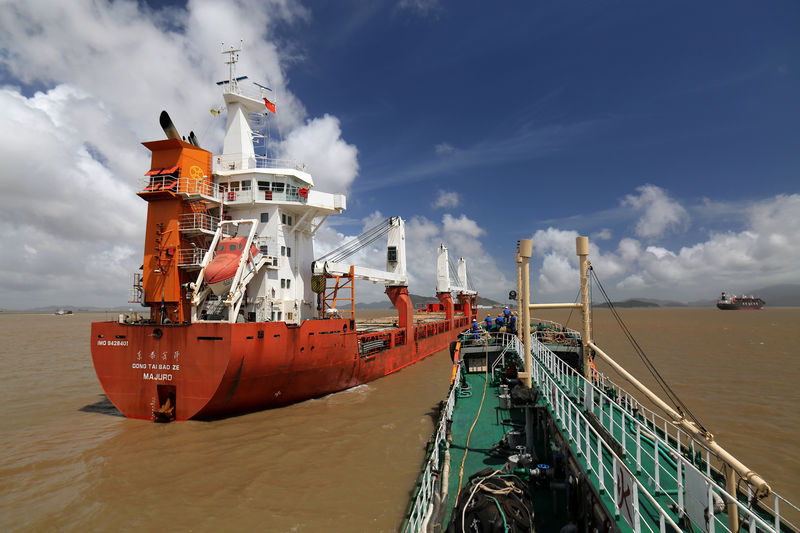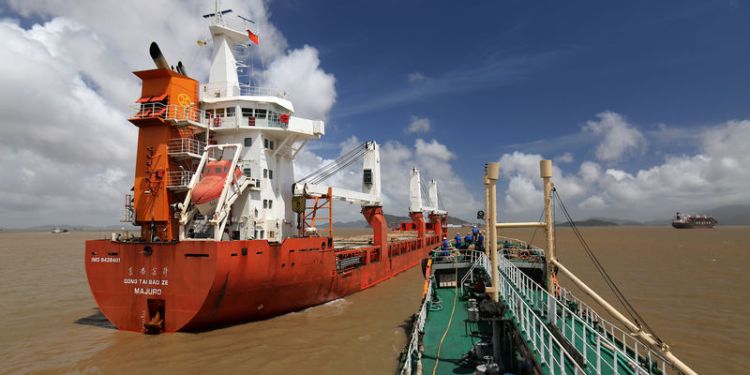 © Reuters. Sinopec oil tanker approaches cargo vessel Dongtai Baoze berthed at an anchorage off Zhoushan port to supply it with bunker fuel
© Reuters. Sinopec oil tanker approaches cargo vessel Dongtai Baoze berthed at an anchorage off Zhoushan port to supply it with bunker fuelBy Chen Aizhu and Roslan Khasawneh
ZHOUSHAN, China/SINGAPORE (Reuters) – China’s port city of Zhoushan is planning to challenge Singapore’s dominance of the multi-billion dollar shipping fuel industry, relying on proximity to some of the world’s biggest ports and Beijing’s support to give it an edge.
It will be steep going. The port facilities in the cluster of islands around Zhoushan have annual marine fuel sales of 3.6 million tonnes, less than a tenth of the record 50.6 million tonnes of shipping or bunker fuel Singapore sold in 2017.
Zhoushan, though, was ranked fourth in global container traffic in 2016, according to the World Shipping Council, and it sits 150 km (90 miles) from the world’s biggest container port at Shanghai, and within a day’s voyage of other major ports including Ningbo and Nanjing.
Zhoushan wants to go after the fuelling business represented by this traffic, and many shippers and analysts expect it to mount the first serious challenge to Singapore in decades.
It’s not just bunkers. A thriving bunker market attracts valuable secondary businesses – shipping supplies, maintenance and repairs, insurance and other maritime financial services – worth billions of dollars more a year.
“With over 3 billion-tonnage freight handled by Zhoushan and nearby ports, that exceeds Singapore … We shall not miss the vast market in front of our door,” said Ying Zhongmin, head of policy and regulations at Zhoushan Free Trade Zone.
Singapore handled almost 630 million tonnes of cargo in 2017, with vessel arrivals totaling 2.8 billion tonnes, according to government data.
Zhang Haichao, chairman and general manager of Sinopec Corp (SS:) unit Sinopec Sales Co, said at an industry event in October that by 2030 Zhoushan’s bunkering volumes will have risen to 30 million tonnes a year, in keeping with targets set by port authorities.
Nearby, there are a half-dozen fuel producers, including the 400,000 barrels-per-day (bpd) Zhejiang Petrochemical Corp plant to be launched at year-end. Zhoushan could lure in oil and LNG tankers, dry-bulk carriers bringing raw materials from Australia, and container ships heading to the U.S. West Coast.
“Vessels calling on China close to Zhoushan and north of it, as well as Japan and (South) Korea, will definitely give it a close look,” said Ashok Sharma, managing director of shipbroker BRS Baxi in Singapore.
Chinese vessels would find it particularly attractive, he said.
GRAPHIC: Top 20 Container Ports – https://tmsnrt.rs/2RwkEY0
CLEAN FUEL REGULATIONS
Zhoushan plans to take advantage of marine fuel regulations that will cap sulfur content in shipping fuel at 0.5 percent from 2020, down from 3.5 percent.
The new International Maritime Organization (IMO) rules mean three-quarters of the 4 million barrels per day (bpd) of high-sulfur fuel oil (HSFO) now consumed by global shippers will shift to low-sulfur fuels like marine gasoil (MGO) and low-sulfur fuel oil (LSFO).
While Singapore has three major refineries – owned by Royal Dutch Shell (AS:), Exxon Mobil (N:) and the joint-venture Singapore Refining Company – they are geared for high-value product exports and not marine fuels. Under the IMO rules, Singapore will have to import these fuels, including from producers in China and the Middle East, inflating costs.
“Chinese ports like Zhoushan will be closer to the source of production of the new compliant fuel,” said Ralph Leszczynski, head of research at ship broker Banchero Costa in Singapore. “The pricing could potentially turn to Zhoushan’s advantage.”
Sinopec, Asia’s biggest oil refiner, moved its global bunker fuel center to Zhoushan from Beijing in May and is preparing to pump IMO-compliant fuel from 2019.
Top global independent oil merchant Vitol has also set up a trade office in Zhoushan for bunkers and other oil products in a joint operation with Zhejiang Seaport Group, said Zhoushan government officials and industry sources.
Vitol declined to comment.
While Zhoushan may chip away at some of Singapore’s bunker market share, its success depends on factors such as the cost and efficiency of its fuelling infrastructure, where Singapore is unrivalled, BRS Baxi’s Sharma said.
“Zhoushan will find it challenging to achieve the same standards and ease of doing business.”
GRAPHIC: Major Bunker Ports – https://tmsnrt.rs/2RpRyK4
HARD TO TOP
China has 11 licensed bunker suppliers, including state-run Sinopec and Chimbusco, and independents such as Herun Group and Zhoushan Seaport Group, all operating in Zhoushan.
They are up against more than 50 outfits in Singapore, alongside the world’s busiest shipping lane and supplying some of the cheapest marine fuel available.
“Zhoushan is gaining some traction in competition to South Korea on bunker prices, but it still is quite a distance behind Singapore in terms of efficiency and infrastructure,” said an executive with China’s Nanjing Tanker Corp, which refuels some of its 65 vessels at the port.
A ship can refuel in around six hours in Singapore, while in Zhoushan it can take much longer due to greater bureaucracy, according to industry participants.
Ships take bunkers in Singapore because of its efficiency, transparency and strict standards, which translate into saved costs and time.
“The Maritime and Port Authority of Singapore … continues to implement and uphold high standards,” said an MPA spokeswoman, citing the required use of mass flow meters for fuel oil deliveries from 2017, and the extension of that requirement to gasoil in mid-2019.
GRAPHIC: China challenges Singapore’s bunker fuel dominance – https://tmsnrt.rs/2RwlILu
Zhoushan was approved as a free trade zone in early 2017, and was the first Chinese city allowed to grant marine fuel licenses. In October this year, it announced a new import regulation on marine blending fuels, a move to serve a broader range of shippers’ needs.
Zhoushan has also asked the Ministry of Finance for a waiver on a consumption tax on bunker sales, and a rebate on value-added taxes for locally produced marine fuels, officials said.
($1 = 6.9435 yuan)
Source: Investing.com






















